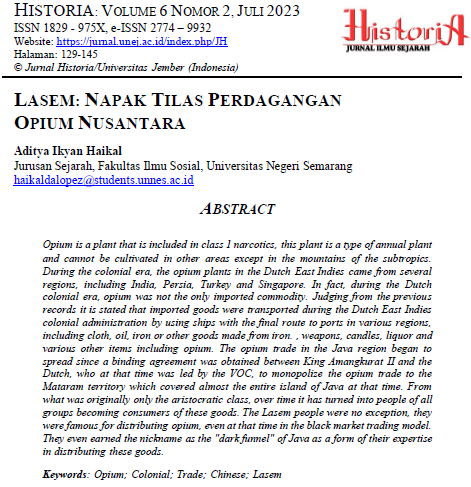LASEM: NAPAK TILAS PERDAGANGAN OPIUM NUSANTARA
DOI:
https://doi.org/10.19184/jh.v6i2.37392Keywords:
Lasem, Opium, Kolonial, Perdagangan, Peranakan TiongkokAbstract
Opium is a plant that is included in class 1 narcotics, this plant is a type of annual plant and cannot be cultivated in other areas except in the mountains of the subtropics. During the colonial era, the opium plants in the Dutch East Indies came from several regions, including India, Persia, Turkey and Singapore. In fact, during the Dutch colonial era, opium was not the only imported commodity. Judging from the previous records it is stated that imported goods were transported during the Dutch East Indies colonial administration by using ships with the final route to ports in various regions, including cloth, oil, iron or other goods made from iron. , weapons, candles, liquor and various other items including opium. The opium trade in the Java region began to spread since a binding agreement was obtained between King Amangkurat II and the Dutch, who at that time was led by the VOC, to monopolize the opium trade to the Mataram territory which covered almost the entire island of Java at that time. From what was originally only the aristocratic class, over time it has turned into people of all groups becoming consumers of these goods. The Lasem people were no exception, they were famous for distributing opium, even at that time in the black market trading model. They even earned the nickname as the "dark funnel" of Java as a form of their expertise in distributing these goods.
Keywords: Opium; Colonial; Trade; Chinese; LasemDownloads
References
Carey, P. (1984). Changing Javanese Perceptions of the Chinese Communities in Central Java, 1755-1825. East.
Fathoni, A. (2020). Dari Opiumpacht Hingga Opiumregie: Pasang Surut Perdagangan Opium di Keresidenan Kediri, 1833-1931.
Ibrahim, J. (2016). Candu Dan Militer Keterlibatan Badan-Badan Perjuangan Dalam Perdagangan Candu Di Jawa Pada Masa Revolusi. Jurnal Kawistara, 6(1), 76. https://doi.org/10.22146/kawistara.15495
Laksono, Anton Dwi. 2018. Apa Itu Sejarah: Pengertian,Ruang Lingkup, Metode dan Penelitian. Pontianak: Derwati Press.
Lestari, S., & Wiratama, N. (2018). DARI OPIUM HINGGA BATIK : LASEM DALAM “ KUASA †TIONGHOA ABAD XIX-XX. Jurnal Patrawidya, 19, 253–270.
Nugroho, A. (2018). Perdagangan Opium Di Karesidenan Jepara Tahun 1870-1932. 404–416.
Nurhajarini, D. R., Purwaningsih, E., & Fibiona, I. (2015). Akulturasi Lintas Zaman di Lasem: Perspektif Sejarah dan Budaya (Kurun Niaga-Sekarang). http://repositori.kemdikbud.go.id/id/eprint/1131
Nurkholis, D. (2022). Dinamika Perdagangan Opium di Surakarta Tahun 1886-1928. UNS.
Salsabila, R., Widiadi, A. N., & T. Leksana, G. (2022). Dari Impor Hingga Ke Tangan Konsumen: Perdagangan Opium di Karesidenan Surabaya, 1870-1898. Fajar Historia: Jurnal Ilmu Sejarah Dan Pendidikan, 6(1), 111–127. https://doi.org/10.29408/fhs.v6i1.5349
Saputra, M. (2022). PERKEMBANGAN TREM BATAVIA 1869-1930. 13(1), 74–92.
Sari, S. (2022). CANDU DI MADURA TAHUN 1894-1949. Jurnal Avatara, 13(1), 1–18.
Trianasari, D. (2020). PERDAGANGAN OPIUM DI SURAKARTA TAHUN 1899-1942. Jurnal Prodi Ilmu Sejarah, 5(3), 248–253.






